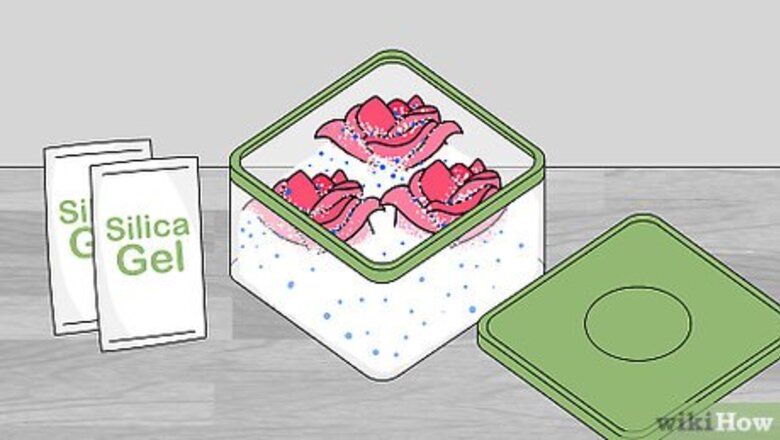
views
Using Silica Gel
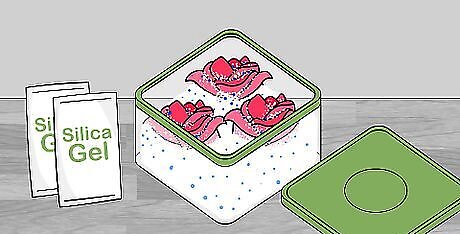
Choose your prefered blooms and place them in silica gel. Select blooms without moisture. The rose needs to be dry to the touch but should not be too dry that it loses its brilliance. The drying process magnifies and flaws of your rose especially if it has moisture. Pour 2 inches of silica gel (available at craft stores) into an airtight container. Cut the stems to about 2 inches and place the rose in the Silica Gel stem down. Using a circular motion, gently pour the Silica Gel over the roses. Fill the container and make sure the container remains airtight by using masking tape to seal the lid shut. Keep in mind that the deeper the colour, the longer it will last once preserved. Use a small container to pour the Silica Gel to give you more control. Make sure you get Silica Gel between each petal but don’t squish or damage the petals. Use a stick to keep the petals upright and separated as you pour in the Silica Gel. Keep at least one inch of Silica Gel to separate multiple roses in the same container. Be sure to record the name of the flower and the date on which you sealed it. Keep the container sealed for at least 2 weeks for standard roses and 1 week for mini roses. Alternatively, you can microwave the gel and flower in a microwave safe dish for 2 to 5 minutes on a low setting. Leave it out to sit for 24 hours before cleaning off the gel.
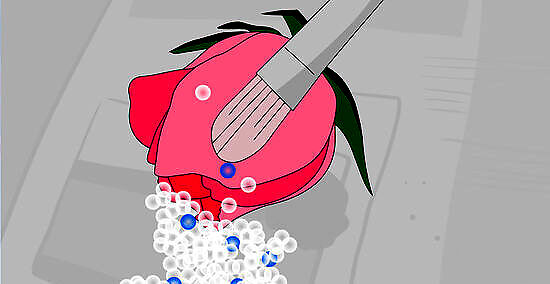
Remove the flower from the Silica Gel. Pour out the silica gel carefully into another container. Hold the rose upside down by the stem and gently brush off Silica gel. Use a small paintbrush or makeup brush to gently remove the Silica gel. You may keep fallen petals and glue them on later. To attach loose petals, use a glue gun or a toothpick with a drop of tacky glue. Around the outer base of the calyx on the underside of the bloom, attach a fallen petal with just a tiny drop of glue to make sure that it remains inconspicuous. Allow the glue to dry for at least 24 hours.
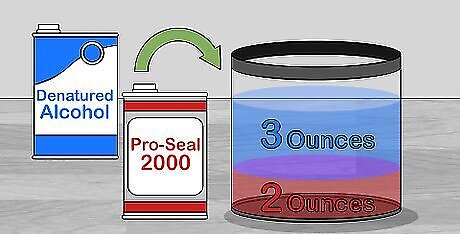
Create a finish. Put on protective gear including rubber gloves, face mask, and protective goggles. Mix 2 ounces of pro-seal 2000 and 3 ounces of denatured alcohol in a bucket. Prior to an ARS rose show, Pro-seal 2000 should not be used. Pro-seal is a clear, glossy varnish typically used in construction. While it will preserve your rose, make sure that you are careful using it. Always wear gloves and protective goggles. Denatured alcohol is often used as a house cleaner but is toxic when ingested so be sure to wear protective gear and wash your hands thoroughly after handling.

Spray on your finish. Using a 6 ounce preval spray gun, spray your mixture of 2 ounces of pro-seal 2000 and 3 ounces of denatured alcohol to apply a thin coat to all the surfaces of the rose. Apply the finish at 70 degrees fahrenheit with a 50% humidity or less. Let the rose dry for 24 hours or more. Once dry, repeat the process and add a second coat.
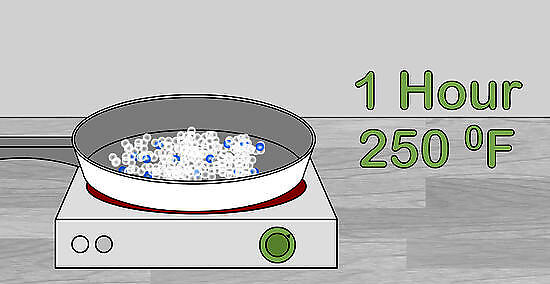
Recover your Silica Gel. Remove the moisture from your silica gel by placing it in an oven pan for an hour at 250 degrees fahrenheit. Once you see vivid blue cobalt crystals remove them and cool at room temperature. Once cool, place them in an airtight container and seal the lid with masking tape.
Drying a Rose

Use a colour guide to help you choose which variety to dry. There are a multitude of rose varieties that keep their brilliance even when dried. From classic red roses to vibrant purple ones, use this guide to help choose a variety best suited for you: Red and red blends: Veterans’ Honour, Miss Flippins, Olympiad, AceyDeucy, Mountie, Hilde, Coffee Bean, Chelsea Belle, Black Jade, Christian Dior. Pink and pink blends: Show Stopper, Fame, Adams Smile, Timeless, Hanna Gordon, Prima Donna, Rina Hugo,Giggles, Gemini, Valeria Jeanne, Doris Morgan. Orange and orange blends: Kanegem, Starina, Gingersnap, Tropicana, Impatient, Rio Samba, Denver’s Dream, Hot Tamale, Fragrant Cloud, Mardi Gras, Perrine, Copper Sunset. Yellow and yellow blends: Cal Poly, Julia Child, Henry Fonda, Behold, Summer Sunshine, Sunsprite, Midas Touch, Rainbow’s End, Oregold, Bees Knees, Gold Metal, Rise’n’Shine, Glory Be. Apricot and apricot blends: Holy Toledo, Honey Perfume, Amber Sunblaze, Tahitian Sunset, Apricot Twist, Michel Cholet, Angel’s Blush, Jeanne Kenneally, Joycie, Autumn Sunset. Purple and mauve: Lavender Jewel, Barbra Streisand, Dr John Dickman, Fragrant Plum, Vista, Ebb Tide, Winsome, Distant Drums, Wild Blue Yonder. Russets: Teddy Bear, Hot Cocoa, Copper Sunset Fun colours: Gizmo,Fourth of July, Fancy Pants, Purple Tiger, Neon Cowboy, Hurdy Gurdy.

Use a heavy book and absorbent paper. Protect the pages of your book by using absorbent paper on either side of your rose as pigments in the petals and stem may stain them. Place a rose every ⅛ inch between the pages of the book. Close the book and weigh it down with more books or other heavy items. Let the flowers dry for about a week before checking on them. Replace the absorbent paper every week and allow the roses to dry for up to 3 weeks or more. Make sure the roses are as dry as you can make them before pressing them. Do not place them in the book directly from the vase. Shake off excess water.
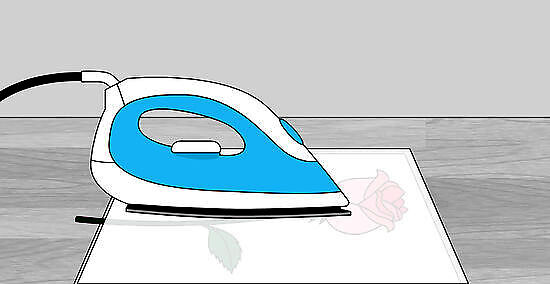
Use an iron without any water. Place each rose between absorbent paper and heat an iron to its lowest setting. Make sure that there is no water in the iron because you do not want moisture from steam to ruin the process. Flatten the rose with a book after placing it in between the 2 absorbent pieces of paper. Press the iron on the top sheet for 10 -15 seconds. Wait for 10 -15 seconds and repeat. Do not use a gliding motion but rather just press the iron down onto the top sheet. Check by gently lifting the top sheet to make sure the flower is dry.

Air dry your roses. When the roses are about to open, hang in a dry, dark, and warm area. make sure that there is good ventilation and allow them to dry for about 2 - 3 weeks. Hang them upside down using a string to tie the stems together. Hanging them upside down prevents moisture from being trapped in the petals. Moisture can lead to mold which can damage your flowers. The roses will shrink as they dry. You may need to retie them together if the string is no longer tight around them. Be careful when handling the dried flowers as they can be very brittle.

Protect the dried flowers. Do not expose the dried roses to direct sunlight. Avoid placing them under a table lamp. Display dried flowers in a glass dome or box to avoid handling as they can be extremely brittle.
Extending the Life of Your Cut Roses
Use a sanitized vase. Thoroughly wash a vase with hot water and soap. Use a bottle brush to scrub out any residue and then soak the vase in a 5% dilution of bleach for a several minutes. Create a 5% dilution with one cup of bleach for every gallon of water. You should also use this dilution for cleaning your scissors before cutting your roses. Bacteria that deteriorate freshly cut roses may reside in vases that have not been clean.
Water your roses and make note of which blooms you want to cut. Water your roses well the night before cutting them. The roses will have more substance thanks to the extra drink of water. While you water, make note of the location of the blooms you want to cut so that you can immediately refrigerate them after you have cut them in the morning.

Cut your roses at the ideal time of day. Cut your roses in the morning. You may cut them as early as you have daylight, which can be anywhere from 5:00 am to as late as 10:00 am depending on the time of year. Cut your roses earlier if the weather is hot. In contrast, cut your roses later if there is a lot of morning dew. Try not to cut your roses at midday or later as they will have the least amount of substance. Keep your roses cool. Roses will last longer in cool weather and deteriorate in heat. If the weather is cool, you may be able to cut your roses later in the day.

Be mindful of how open you want you roses before cutting. The degree of openness you want for your roses depends on their intended use. Cut the roses just after their budding stage as the petals just start to unfurl if you want them to last longer, like in the use of a bouquet. The variety of rose will open determine when you should cut them as some may be cut at a more open stage. For example St. Patrick and Moonstone roses have many petals and can be cut when they are more open.

Cut and re-cut the rose stems. Cut the stems at an angle with clean, sharp cutters. The angle prevents the rose from standing flat, blocking any water from being absorbed. Place the roses in lukewarm or cold water as soon as they have been cut. Re-cut the stems when you have them underwater to eliminate air bubbles that can lead to premature wilting and shorten the life of your rose. Remove any foliage below the waterline if you’re using the roses for a bouquet.

Condition and refrigerate your bouquets. Fill a bucket of water so that the stem of the flower is completely under water but the bloom remains dry. Let the flowers drink the water in a cool and dark room for an hour. Refrigerate your roses at 38 degrees fahrenheit or until you are about to use them. Cut roses will last longer if they are placed in the fridge overnight as you sleep.

Select long-lasting rose varieties. Florists bread roses to last long once placed in a vase. If you are using you own roses, make note of which last longer once cut. Hybrid teas tend to last longer than antique roses. Varieties that tend to last longer in vases are: Crystalline Secret Red Intuition St. Patrick Veteran’s Honor Black Magic Andrea Stelzer Louise Estes Moonstone Elizabeth Taylor
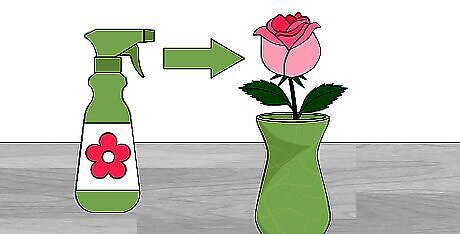
Use flower preservation products and change the vase water often. Floral preservative can be purchased online or at your local flower shop or garden supply store. They can be added to the vase water to extend the life of the roses. Change the vase water often as old water contains bacteria. Softened water may contain salt that is not good for roses. Cut your roses under water every day as you change the vase water.


















Comments
0 comment